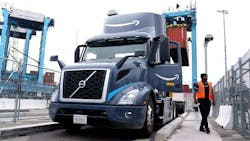Amazon Deploys 50 Heavy-Duty Electric Trucks for First and Middle Mile Delivery Operations in Southern California
Amazon announced it has launched 50 heavy-duty electric trucks in Southern California - the company's largest fleet of these vehicles in any country so far. The launch represents an important milestone in Amazon's work towards decarbonizing every step of its delivery process across the first, middle, and last mile.
The battery-electric Class 8 Volvo VNR Electric trucks feature a range of up to 275 miles and a gross combined weight of 82,000 pounds. The heavy-duty vehicles also feature significantly lower noise levels and safety features such as active collision mitigation and blind-spot detection.
To support the new electric vehicles, Amazon also installed over 45 DC fast chargers across 11 of its sites to ensure uninterrupted service.
“We’re proud to launch our largest fleet of electric heavy-duty vehicles yet in California,” said Udit Madan, VP of Worldwide Amazon Operations. “Heavy-duty trucking is a particularly difficult area to decarbonize, which makes us all the more excited to have these vehicles on the road today. We’ll use what we learn from deploying these vehicles as we continue to identify and invest in solutions to reduce emissions in our transportation network and to impact sustainability in the trucking industry more broadly.”
Explore More on Vehicle Electrification at the T&D World Live Conference
Happening October 1-3 in Atlanta
The fully electric trucks will haul cargo containers and customer packages in Amazon's first- and middle-mile operations, joining hundreds of last-mile electric vans already delivering packages across California.
The first mile is where goods are moved from the manufacturer, through customs, into ports, and into Amazon's fulfillment network. To accompany these new electric trucks, Amazon has also deployed its first electric drayage trucks at the Ports of Los Angeles and Long Beach, with more expected to be on the road by the end of 2024.
The middle mile is where goods are moved between fulfillment centers, sort centers, air facilities, and finally, delivery stations, where the packages are loaded onto last-mile vans to be delivered to the customer.
In total, these trucks are expected to travel more than 1 million miles annually with zero tailpipe emissions.
About the Author
Breanna Sandridge, Senior Editor
Breanna Sandridge is senior editor for EnergyTech and Microgrid Knowledge, both part of the energy group at Endeavor Business Media.
Prior to that, Breanna was managing editor for Machinery Lubrication and Reliable Plant magazines, both part of Noria Corp. She has two years experience covering the industrial sector.
She also is a 2021 graduate of Northeastern State University (Oklahoma) with a Bachelor's in English.
